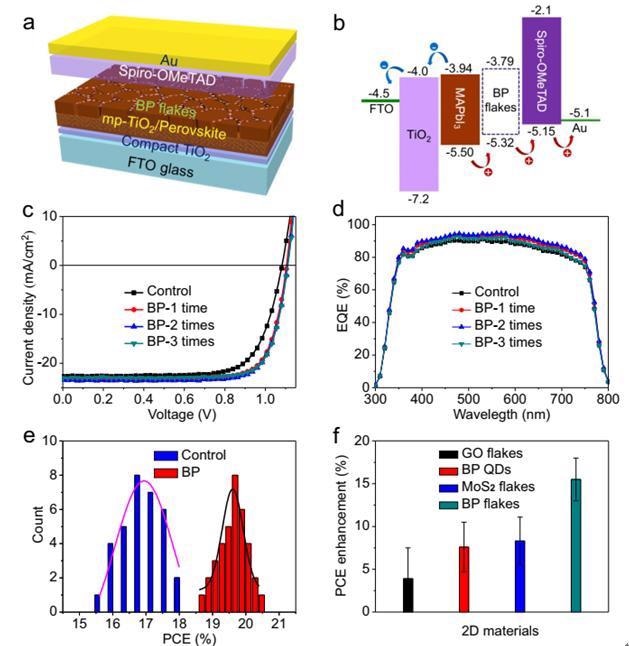Apr 2 2021
In perovskite solar cells (PSCs), grain boundaries (GBs) have been identified to be detrimental to the photovoltaic performance of the devices.
 (a, b) The structural schematic diagram and energy-level band diagram of a BP-modified PSC with a normal structure. (c, d) Current density-voltage (J-V) curves (reverse scan) and external quantum efficiency (EQE) spectra of PSCs without (control) and with BP deposition (1~3 times) on perovskite film surface. (e) Histogram of power conversion efficiencies (PCEs) of PSCs without (control) and with BP modification (BP coating for 2 times). The PCEs are derived from the reverse scans of the J-V curves. (f) The average PCE enhancement after the modification of perovskite films with different 2D materials. Image Credit: Peng You, Guanqi Tang, Jiupeng Cao, Dong Shen, Tsz-Wai Ng, Zafer Hawash, Naixiang Wang, Chun-Ki Liu, Wei Lu, Qidong Tai, Yabing Qi, Chun-Sing Lee, and Feng Yan.
(a, b) The structural schematic diagram and energy-level band diagram of a BP-modified PSC with a normal structure. (c, d) Current density-voltage (J-V) curves (reverse scan) and external quantum efficiency (EQE) spectra of PSCs without (control) and with BP deposition (1~3 times) on perovskite film surface. (e) Histogram of power conversion efficiencies (PCEs) of PSCs without (control) and with BP modification (BP coating for 2 times). The PCEs are derived from the reverse scans of the J-V curves. (f) The average PCE enhancement after the modification of perovskite films with different 2D materials. Image Credit: Peng You, Guanqi Tang, Jiupeng Cao, Dong Shen, Tsz-Wai Ng, Zafer Hawash, Naixiang Wang, Chun-Ki Liu, Wei Lu, Qidong Tai, Yabing Qi, Chun-Sing Lee, and Feng Yan.
According to several research papers, the defects present in perovskite GBs should be passivated by using appropriate materials, like CH3NH3I, fullerene derivatives, and quaternary ammonium halide to mitigate carrier recombination and accordingly enhance the performance of the device.
A research team, under the guidance of Professor Feng Yan from the Department of Applied Physics of The Hong Kong Polytechnic University, Hung Hom, Kowloon, Hong Kong, and colleagues have devised an innovative technique to deal with the disadvantage of perovskite GBs without defect passivation. Many 2D materials, such as MoS2, graphene oxide (GO), and black phosphorus (BP), are particularly altered on the edge of perovskite GBs by a solution process.
The findings of the study have been reported in a new paper published in the Light: Science & Applications journal.
The 2D materials exhibit high carrier mobilities, smooth surfaces, and ultrathin thicknesses without any dangling bonds. The power conversion efficiency (PCE) of the devices is considerably improved by the 2D flakes, where BP flakes can trigger the highest relative improvement of around 15%. More interestingly, under certain conditions, GBs altered with the 2D materials were found to be desirable for the performance of the devices.
For the first time, the researchers have noted a synergistic impact between the perovskite GBs and 2D flakes. The nanotechnology of using 2D materials in PSCs has already been described in a few papers, but the synergistic impact between the 2D flakes and perovskite GBs has not been reported so far. To gain better insights into the basic mechanism of the above impact, device simulation was carried out with the help of a commercial software.
The researchers clearly demonstrated the hole conduction processes from GBs to 2D flakes in PSCs, indicating that the 2D flakes and GBs all serve as hole channels in the devices. The results of the simulation verify that the improvement in performance induced by BP is higher compared to that induced by other 2D materials due to the maximum possible hole mobility of BP.
Moreover, the impact of the alteration of the 2D flakes on the perovskite grains remote from GBs on the performance of the device is very little, signifying that the synergistic impact of 2D flakes and perovskite GBs is necessary for the improvement in the performance of the devices.
The coverage of the 2D flakes on the perovskite films is only a few percent, but a majority of the flakes are situated on perovskite GBs. Thanks to the high carrier mobilities of the 2D materials, particularly BP, the transfer of holes from GBs is drastically improved in the PSCs, thus leading to significant enhancements of the efficiency and the stability of the devices.
Moreover, such findings signify that GBs in PSCs are not unfavorable for the device performance if the holes collected in the GBs can be conducted out efficiently. In some circumstances, GBs can even be beneficial for the photovoltaic performance of the PSCs as a result of the built-in electric fields near them, which can enable the separation and transfer of photocarriers in the devices.
Thus, perovskite GBs are electrically benign, which agrees with certain theoretical calculations reported previously. Most significantly, the synergic impact of the 2D flakes on the GBs in PSCs was observed for the first time.
Not only the location of the 2D flakes on the surface of the perovskite but also the carrier mobility is crucial for the improvement of the performance. This study offers a guideline for altering perovskite layers with innovative high-mobility 2D materials to enhance the photovoltaic performance and the stability of PSCs.
Journal Reference:
You, P., et al. (2021) 2D materials for conducting holes from grain boundaries in perovskite solar cells. Light: Science & Applications. doi.org/10.1038/s41377-021-00515-8.